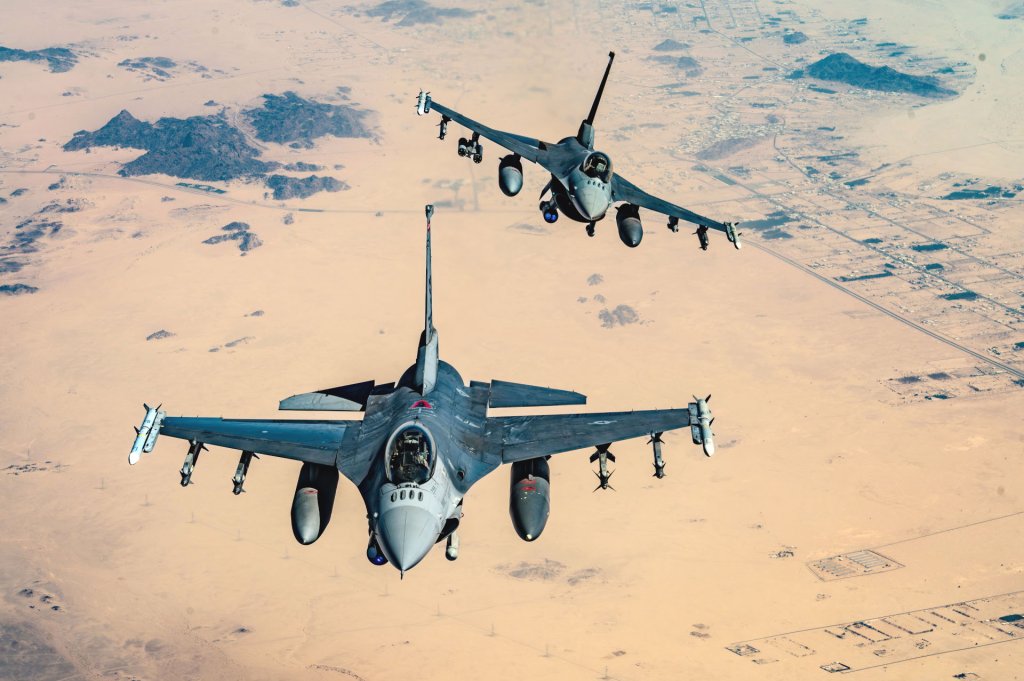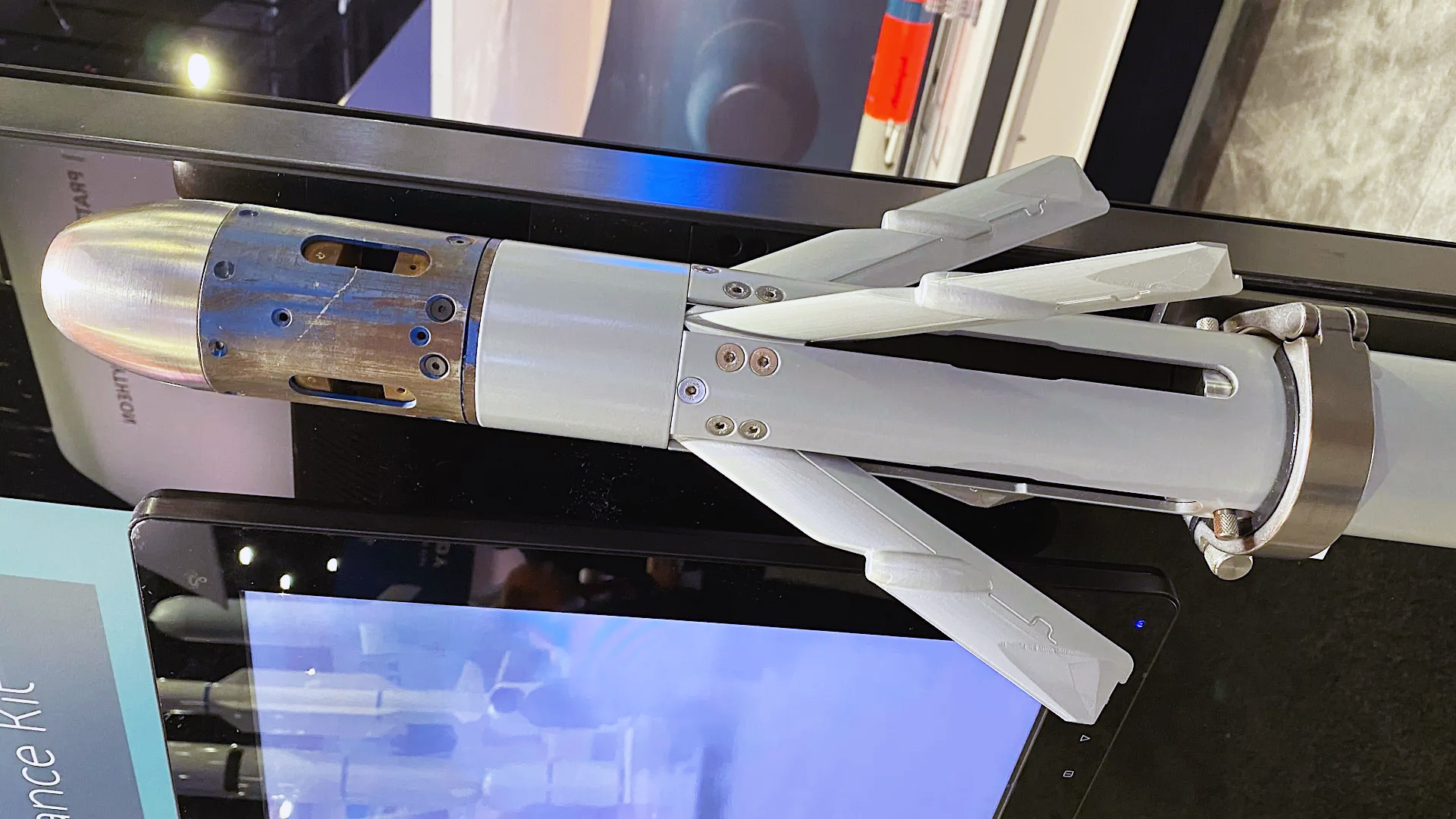We now have our first look at a new version of the Advanced Precision Kill Weapon System II (APKWS II) 70mm guided rocket with an infrared seeker on top of the existing laser guidance capability. The dual-mode APKWS II allows the launch platform to more rapidly engage multiple targets in succession, which could be particularly valuable in the air-to-air role when facing down large groups of drones or cruise missiles.
BAE Systems unveiled the dual-mode APKWS II configuration at the Navy League’s Sea Air Space 2025 exhibition, at which TWZ was in attendance. TWZ was the first to report that an additional passive infrared seeker was in the works for APKWS II, which emerged in the 2025 Marine Aviation Plan released earlier this year.

The new infrared seeker is fitted to the nose of an otherwise standard laser-guided APKWS II rocket. In a typical engagement, an operator would initially lase the target to lock the infrared seeker onto it. Then, after firing, the new APKWS variant would travel to its target autonomously.
In this way, the dual-mode APKWS II offers a major increase in efficiency over having to maintain a laser lock on the target throughout the weapon’s flight. With this pseudo-fire-and-forget capability, the crew of the launch platform can more rapidly move on from engaging one target to the next.
So, to summarize, an operator would initially lase the target to lock the infrared seeker onto it. Then after firing, the new APKWS variant would travel to its target autonomously. This is a major increase in efficiency over having to maintain a laser lock on the target throughout the weapon’s flight.

TWZ highlighted exactly these factors in our previous reporting on work on an infrared seeker for APKWS II and what that would bring to the table, especially for anti-air use, writing:
“Still, there are real limitations to APKWS in the anti-air role, whether fired from the ground or the air. It is generally usable against slower-flying drones and some cruise missiles, both of which are largely non-reactionary, non-hard-maneuvering targets. They also require the target to be lased (laser-designated) throughout the rocket’s flight. In other words, this is not a ‘fire-and-forget’ weapon, it needs to have its target illuminated until the warhead detonates. This limits the rapidity of multiple engagements and, especially for air-to-air applications, makes engagements tricky. For the latter, having one aircraft lasing and one firing would help with these limitations, especially considering that the rocket has limited range and speed, and the firing aircraft has to clear any blast fragmentation area quickly in order to not be struck by its own weapon’s effects.”
“What would make these engagements far easier is if the APKWS rocket was equipped with its own infrared seeker, something we have mentioned before. This would allow it to lock on before launch and fly to its target autonomously. This means multiple targets could be engaged far faster and, in many cases, in a safer manner. It also means that radar could be used to help initially acquire the target and point the seeker at it prior to firing, both in ground and air-based applications.”
The dual-mode APKWS II represents a next-generation evolution of the munition. The basic configuration consists of a laser guidance kit slotted in between one of a variety of warhead options and a standard 70mm rocket motor. This arrangement has been key to helping keep the overall unit cost of the munitions down, as well as allowing for the use of existing warhead and rocket motor stocks. The price point for the laser guidance unit is between $15,000 to $20,000, with the other components typically adding another few thousand dollars to the total cost.

Putting the infrared seeker on the nose of the dual-mode APKWS II is prompting changes to the warhead arrangement, which is still being finalized. The new version will use a mid-body warhead instead of the typical nose-mounted one, but there is no expected to be any loss of lethality. The new configuration may in fact be more effect that existing blast-fragementaion warheads.
How the new warhead configuration, together with the additional infrared seeker, will impact the unit cost of the dual-mode APKWS II compared to the baseline version is unclear, but affordability remains a focus of the design.

Even if the dual-mode APKWS II is two or three times more expensive than laser-guided-only types, it would still be significantly cheaper than traditional air-to-air and surface-to-air missiles. Current generation AIM-9X Sidewinders and AIM-120 Advanced Medium-Range Air-to-Air Missiles (AMRAAM) air-to-air missiles have price tags around $450,000 and $1 million, respectively. The latest variants of the Stinger short-range man-portable surface-to-air missile reportedly each cost around $400,000, while higher-end interceptors like the Patriot PAC-3 Missile Segment Enhancement (MSE) have a price tag of close to $4.2 million.
As noted, the dual-mode seeker would also be a valuable addition for engaging threats on land and at sea, and doing so more rapidly. There is another 70mm rocket with an infrared seeker on the market now, the U.S.-South Korean Low-cost Guided Imaging Rocket (LOGIR), which was developed primarily for coastal defense and other maritime applications.

The baseline laser-guided APKWS II is already a combat-proven munition in the air-to-surface, surface-to-surface, surface-to-air, and air-to-air roles. TWZ was first to confirm earlier this year that U.S. Air Force F-16 fighters have been using APKWS II rockets as air-to-air munitions to down Houthi drones over and around the Red Sea. It has since emerged that those rockets have been optimized for use against aerial targets with the help of a software modification called FALCO, which stands for Fixed Wing, Air Launched, Counter-Unmanned Aircraft Systems Ordnance. The Air Force first announced it had demonstrated the ability of APKWS II to serve as an air-to-air weapon back in 2019.

Dual-mode APKWS II will also retain the magazine depth benefits that the baseline version already offers, which again have particular value in the air-to-air role. A traditional air-to-air for the F-16, for instance, is just six missiles. Swapping just one of those missiles for a pair of seven-shot 70mm rocket pods, something we have seen on Vipers operating in the Red Sea region, more than triples the number of total engagement opportunities that the jet has on a single sortie.

U.S. operations against the Houthis in Yemen, as well as in the defense of Israel since October 2023, have underscored the importance of magazine depth when trying to shield against large waves of incoming drones and missiles. During the response to Iran’s drone and missile barrage on Israel in April 2024, the crew of at least one Air Force F-15E Strike Eagle switched to the aircraft’s 20mm M61 Vulcan cannon after running out of missiles, but was unable to bring down anything with the gun. In that instance, aircraft were also landing to rearm while threats were still passing overhead.
These are scenarios that U.S. forces could expect to play out in even larger forms in future higher-end fights, especially a potential one against China in the Pacific. Interestingly, Air Force F-16s based in Japan have also been observed with air-to-air loadouts that feature APKWS II rockets during exercises.
The addition of the infrared seeker to the proven APKWS II package raises the possibility of future iterations of the design, as well. Development of the dual-mode version could be wrapped up as soon as the end of 2026. When a branch of the U.S. military or any other customers might field it remains unknown.
Regardless, the new dual-mode guidance capability is a major development for the already highly-proven APKWS II rocket.
Howard Altman contributed to this story.
Author’s Note: The direct quotes originally in this story have been removed as a courtesy to BAE Systems. None of the facts or details were changed.
Contact the author: joe@twz.com
